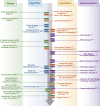Emerging opportunities and challenges for the future of reservoir computing
- PMID: 38448438
- PMCID: PMC10917819
- DOI: 10.1038/s41467-024-45187-1
Emerging opportunities and challenges for the future of reservoir computing
Erratum in
-
Author Correction: Emerging opportunities and challenges for the future of reservoir computing.Nat Commun. 2024 Nov 18;15(1):9971. doi: 10.1038/s41467-024-54397-6. Nat Commun. 2024. PMID: 39557892 Free PMC article. No abstract available.
Abstract
Reservoir computing originates in the early 2000s, the core idea being to utilize dynamical systems as reservoirs (nonlinear generalizations of standard bases) to adaptively learn spatiotemporal features and hidden patterns in complex time series. Shown to have the potential of achieving higher-precision prediction in chaotic systems, those pioneering works led to a great amount of interest and follow-ups in the community of nonlinear dynamics and complex systems. To unlock the full capabilities of reservoir computing towards a fast, lightweight, and significantly more interpretable learning framework for temporal dynamical systems, substantially more research is needed. This Perspective intends to elucidate the parallel progress of mathematical theory, algorithm design and experimental realizations of reservoir computing, and identify emerging opportunities as well as existing challenges for large-scale industrial adoption of reservoir computing, together with a few ideas and viewpoints on how some of those challenges might be resolved with joint efforts by academic and industrial researchers across multiple disciplines.
© 2024. The Author(s).
Conflict of interest statement
The authors declare no competing interests.
Figures




References
-
- Graves, A., Mohamed, A. R. & Hinton, G. Speech recognition with deep recurrent neural networks. In IEEE International Conference on Acoustics, Speech and Signal Processing, 6645–6649 (IEEE, 2013).
-
- LeCun, Y., Bengio, Y. & Hinton, G. E. Deep learning. Nature521, 436–444 (2015). - PubMed
-
- He, K., Zhang, X., Ren, S. & Sun, J. Deep residual learning for image recognition. In IEEE Conference on Computer Vision and Pattern Recognition (CVPR), 770–778 (IEEE, 2016).
-
- Silver, D. et al. Mastering the game of go with deep neural networks and tree search. Nature529, 484–489 (2016). - PubMed
-
- Krizhevsky, A., Sutskever, I. & Hinton, G. E. Imagenet classification with deep convolutional neural networks. Commun. ACM60, 84–90 (2017).
Publication types
LinkOut - more resources
Full Text Sources

